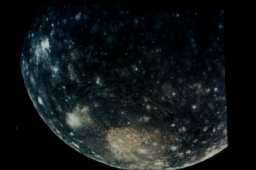This is an image of Proteus, a moon of Neptune.
Click on image for full size
NASA
Evolution of Small Moons
The small moons are too small to be seen, so not much is known about their surface features or composition. With no knowledge of the composition, and no clues from the surface, little can be determined about the course of their evolution. Nevertheless, from the location of some of the moons, as well as their shape, it can be determined that some moons are fragments of a larger moon, or are captured asteroids. Examples of moons such as these are
Epimetheus,
Janus, and
Hyperion.
It is thought that most small moons are icy, however. Therefore their evolution would follow a similar course to that of other icy moons.
You might also be interested in:

Amalthea was discovered by E Barnard in 1872. Of the 17 moons it is the 3rd closest to Jupiter, with a standoff distance of 181,300 km. Amalthea is about the size of a county or small state, and is just
...more
Callisto was first discovered by Galileo in 1610, making it one of the Galilean Satellites. Of the 60 moons it is the 8th closest to Jupiter, with a standoff distance of 1,070,000 km. It is the 2nd largest
...more
Most of the moons and planets formed by accretion of rocky material and volatiles out of the primitive solar nebula and soon thereafter they differentiated. Measurements by the Galileo spacecraft have
...more
Many examples of the differing types of terrain are shown in this image. In the foreground is a huge impact crater, which extends for almost an entire hemisphere on the surface. This crater may be compared
...more
The surface of Callisto is deeply pockmarked with craters. It looks to be perhaps the most severely cratered body in the solar system. There are also very large craters to be found there. The severity
...more
Europa was first discovered by Galileo Galilei in 1610, making it one of the Galilean Satellites. Europa is Jupiter's 4th largest moon, 670,900 km from Jupiter. With a diameter that is about half the distance
...more
The Galileo mission discovered an amazing thing. Europa has its own atmosphere, although it is very, very thin. This atmosphere is created when fast moving molecules in Jupiter's magnetosphere hit the
...more














